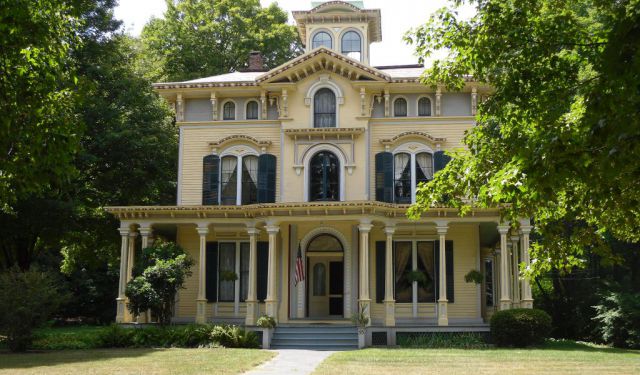Henry Barnard House, Hartford
The Henry Barnard House in Hartford is a National Historic Landmark and the lifelong residence of one of America’s most influential education reformers, Henry Barnard (1811–1900). Barnard played a pivotal role-alongside Horace Mann-in shaping the American public school system, founding statewide education systems in both Connecticut and Rhode Island that served as national models. He was also the first U.S. Commissioner of Education, appointed in 1867.
The house, constructed in 1807, is a three-story brick building with restrained Federal styling. Its five-bay facade features a central entrance flanked by sidelights and pilasters, topped with a semi-circular transom and an Ionic-columned portico. A modillioned cornice adds subtle classical detail. Although the interior has been modified over time-especially due to its later use as a homeless shelter operated by the Sisters of Mercy-it retains its original center hall layout and general character.
Henry Barnard was born in the house in 1811, and the property remained in his family until he died in 1900. A Yale graduate and trained lawyer, Barnard entered the Connecticut legislature in 1837 and soon pushed for state oversight of education after studying European school systems. Although politically ousted from his post in Connecticut, he continued his reform work in Rhode Island, where he helped establish the first normal school-a precursor to teacher training colleges-in the United States. He later returned to Connecticut to implement similar reforms and went on to serve in Maryland, Wisconsin, and at the federal level.
The house was designated a National Historic Landmark in 1965, not only for its architecture but also for its association with Barnard's transformative legacy in American education. Today, it continues to serve the public good as a shelter for the homeless.
The house, constructed in 1807, is a three-story brick building with restrained Federal styling. Its five-bay facade features a central entrance flanked by sidelights and pilasters, topped with a semi-circular transom and an Ionic-columned portico. A modillioned cornice adds subtle classical detail. Although the interior has been modified over time-especially due to its later use as a homeless shelter operated by the Sisters of Mercy-it retains its original center hall layout and general character.
Henry Barnard was born in the house in 1811, and the property remained in his family until he died in 1900. A Yale graduate and trained lawyer, Barnard entered the Connecticut legislature in 1837 and soon pushed for state oversight of education after studying European school systems. Although politically ousted from his post in Connecticut, he continued his reform work in Rhode Island, where he helped establish the first normal school-a precursor to teacher training colleges-in the United States. He later returned to Connecticut to implement similar reforms and went on to serve in Maryland, Wisconsin, and at the federal level.
The house was designated a National Historic Landmark in 1965, not only for its architecture but also for its association with Barnard's transformative legacy in American education. Today, it continues to serve the public good as a shelter for the homeless.
Want to visit this sight? Check out these Self-Guided Walking Tours in Hartford. Alternatively, you can download the mobile app "GPSmyCity: Walks in 1K+ Cities" from Apple App Store or Google Play Store. The app turns your mobile device to a personal tour guide and it works offline, so no data plan is needed when traveling abroad.
Henry Barnard House on Map
Sight Name: Henry Barnard House
Sight Location: Hartford, USA (See walking tours in Hartford)
Sight Type: Attraction/Landmark
Guide(s) Containing This Sight:
Sight Location: Hartford, USA (See walking tours in Hartford)
Sight Type: Attraction/Landmark
Guide(s) Containing This Sight:
Walking Tours in Hartford, Connecticut
Create Your Own Walk in Hartford
Creating your own self-guided walk in Hartford is easy and fun. Choose the city attractions that you want to see and a walk route map will be created just for you. You can even set your hotel as the start point of the walk.
Hartford's Historical Houses Tour
Visiting old houses is like treasure hunting, where you are bound to uncover secrets of the former owners. Hartford was once home to well-known historic figures, whose abodes today have been converted into museums for future generations to explore.
Among these is the Mark Twain House, a former residence of the iconic American author Samuel Clemens, better known as Mark Twain. This Victorian... view more
Tour Duration: 2 Hour(s)
Travel Distance: 3.6 Km or 2.2 Miles
Among these is the Mark Twain House, a former residence of the iconic American author Samuel Clemens, better known as Mark Twain. This Victorian... view more
Tour Duration: 2 Hour(s)
Travel Distance: 3.6 Km or 2.2 Miles
Architectural Jewels
Hartford, Connecticut abounds in one-of-a-kind, artistically unique structures – homes, museums, libraries, and government halls – each with a distinctive look, appeal, and history of their own. Some of them are celebrated works by well-known architects, and display a variety of styles.
Among these jewels is Armsmear, a historic mansion originally built for Samuel Colt, the famed inventor... view more
Tour Duration: 2 Hour(s)
Travel Distance: 3.1 Km or 1.9 Miles
Among these jewels is Armsmear, a historic mansion originally built for Samuel Colt, the famed inventor... view more
Tour Duration: 2 Hour(s)
Travel Distance: 3.1 Km or 1.9 Miles
Hartford Introduction Walking Tour
Hartford, Connecticut is one of the oldest cities in the United States. Founded in 1635, this capital city of Connecticut has a long and storied history. The city offers a multitude of museums, a booming art scene, interesting architecture and excellence in cuisine.
The area where Hartford now sits was once home to Algonquins. More specifically, it was inhabited by the Massacoes, Podunks,... view more
Tour Duration: 1 Hour(s)
Travel Distance: 2.1 Km or 1.3 Miles
The area where Hartford now sits was once home to Algonquins. More specifically, it was inhabited by the Massacoes, Podunks,... view more
Tour Duration: 1 Hour(s)
Travel Distance: 2.1 Km or 1.3 Miles






